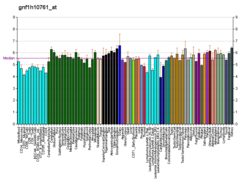Transcription factor MafA is a protein that in humans is encoded by the MAFA gene .[5] Maf family of transcription factors .[6]
MAFA is phosphorylated sequentially on four serine/threonine residues by GSK-3 kinase.[7] [8] [9]
MAFA assists in insulin regulation
edit
An in vivo study on mice proved MafA binds to the promoter in an insulin gene to regulate insulin transcription in response to serum glucose levels.[10] β cell -specific activator, which differentiates it from other transcription factors involved with insulin gene expression .[11] metabolism .[12] oxidative stress .[6]
Interactions
edit
MAFA in neurons
edit
In addition to its expression in pancreatic ßcells, MAFA is also expressed in specific subsets of excitatory and inhibitory neurons. In the peripheric nervous system, it is expressed in touch mechanoreceptors.[14] [15] [8]
References
edit
^ a b c GRCh38: Ensembl release 89: ENSG00000182759 – Ensembl , May 2017^ a b c GRCm38: Ensembl release 89: ENSMUSG00000047591 – Ensembl , May 2017^ "Human PubMed Reference:" . National Center for Biotechnology Information, U.S. National Library of Medicine .^ "Mouse PubMed Reference:" . National Center for Biotechnology Information, U.S. National Library of Medicine .^ "Entrez Gene: MAFA v-maf musculoaponeurotic fibrosarcoma oncogene homolog A (avian)" .^ a b c Aramata; Han (2007). "Roles and Regulation of Transcription Factor MafA in Islet β-cells" . Endocr. J . 54 (5): 659–66. doi :10.1507/endocrj.kr-101 PMID 17785922 . ^ Rocques, Nathalie; Abou Zeid, Nancy; Sii-Felice, Karine; Lecoin, Laure; Felder-Schmittbuhl, Marie-Paule; Eychène, Alain; Pouponnot, Celio (November 2007). "GSK-3-Mediated Phosphorylation Enhances Maf-Transforming Activity" . Molecular Cell . 28 (4): 584–597. doi :10.1016/j.molcel.2007.11.009 PMID 18042454 . ^ a b Lecoin, Laure; Dempsey, Bowen; Garancher, Alexandra; Bourane, Steeve; Ruffault, Pierre-Louis; Morin-Surun, Marie-Pierre; Rocques, Nathalie; Goulding, Martyn; Eychène, Alain; Pouponnot, Celio; Fortin, Gilles; Champagnat, Jean (June 2022). "Mafa-dependent GABAergic activity promotes mouse neonatal apneas" . Nature Communications . 13 (1): 3284. Bibcode :2022NatCo..13.3284L . doi :10.1038/s41467-022-30825-3 . ISSN 2041-1723 . PMC 9174494 PMID 35672398 . ^ Iacovazzo, Donato; Flanagan, Sarah E.; Walker, Emily; Quezado, Rosana; de Sousa Barros, Fernando Antonio; Caswell, Richard; Johnson, Matthew B.; Wakeling, Matthew; Brändle, Michael; Guo, Min; Dang, Mary N.; Gabrovska, Plamena; Niederle, Bruno; Christ, Emanuel; Jenni, Stefan (30 January 2018). "MAFA missense mutation causes familial insulinomatosis and diabetes mellitus" . Proceedings of the National Academy of Sciences . 115 (5): 1027–1032. Bibcode :2018PNAS..115.1027I . doi :10.1073/pnas.1712262115 ISSN 0027-8424 . PMC 5798333 PMID 29339498 . ^ Zhang; Moriguchi (2005). "MafA Is a Key Regulator of Glucose-Stimulated Insulin Secretion" . Mol. Cell. Biol . 25 (12): 4969–4976. doi :10.1128/MCB.25.12.4969-4976.2005 . PMC 1140590 PMID 15923615 . ^ Matsuoka; Artner (March 2004). "The MafA transcription factor appears to be responsible for tissue-specific expression of insulin" . Proc. Natl. Acad. Sci. U.S.A . 101 (9): 2930–3. Bibcode :2004PNAS..101.2930M . doi :10.1073/pnas.0306233101 PMC 365722 PMID 14973194 . ^ Wang; Kataoka (2007). "MAFA controls genes implicated in insulin biosynthesis and secretion" . Diabetologia . 50 (2): 348–58. doi :10.1007/s00125-006-0490-2 . PMC 2196442 PMID 17149590 . ^ a b Zhao, Li; Guo Min; Matsuoka Taka-Aki; Hagman Derek K; Parazzoli Susan D; Poitout Vincent; Stein Roland (March 2005). "The islet beta cell-enriched MafA activator is a key regulator of insulin gene transcription" . J. Biol. Chem . 280 (12): 11887–94. doi :10.1074/jbc.M409475200 ISSN 0021-9258 . PMID 15665000 . ^ Bourane, Steeve; Garces, Alain; Venteo, Stephanie; Pattyn, Alexandre; Hubert, Thomas; Fichard, Agnes; Puech, Sylvie; Boukhaddaoui, Hassan; Baudet, Christel; Takahashi, Satoru; Valmier, Jean; Carroll, Patrick (December 2009). "Low-Threshold Mechanoreceptor Subtypes Selectively Express MafA and Are Specified by Ret Signaling" . Neuron . 64 (6): 857–870. doi :10.1016/j.neuron.2009.12.004 PMID 20064392 . S2CID 14370290 . ^ Lecoin, Laure; Rocques, Nathalie; El-Yakoubi, Warif; Achour, Sarrah Ben; Larcher, Magalie; Pouponnot, Celio; Eychène, Alain (2010). "MafA transcription factor identifies the early ret-expressing sensory neurons" . Developmental Neurobiology . 70 (7): 485–497. doi :10.1002/dneu.20790 . PMID 20213756 . S2CID 421285 .
Further reading
edit
Benkhelifa S, Provot S, Nabais E, et al. (2001). "Phosphorylation of MafA is essential for its transcriptional and biological properties" . Mol. Cell. Biol . 21 (14): 4441–52. doi :10.1128/MCB.21.14.4441-4452.2001 . PMC 87104 PMID 11416124 . Olbrot M, Rud J, Moss LG, Sharma A (2002). "Identification of beta-cell-specific insulin gene transcription factor RIPE3b1 as mammalian MafA" . Proc. Natl. Acad. Sci. U.S.A . 99 (10): 6737–42. Bibcode :2002PNAS...99.6737O . doi :10.1073/pnas.102168499 PMC 124472 PMID 12011435 . Kataoka K, Han SI, Shioda S, et al. (2003). "MafA is a glucose-regulated and pancreatic beta-cell-specific transcriptional activator for the insulin gene" . J. Biol. Chem . 277 (51): 49903–10. doi :10.1074/jbc.M206796200 PMID 12368292 . Matsuoka TA, Artner I, Henderson E, et al. (2004). "The MafA transcription factor appears to be responsible for tissue-specific expression of insulin" . Proc. Natl. Acad. Sci. U.S.A . 101 (9): 2930–3. Bibcode :2004PNAS..101.2930M . doi :10.1073/pnas.0306233101 PMC 365722 PMID 14973194 . Kaneto H, Matsuoka TA, Nakatani Y, et al. (2005). "A crucial role of MafA as a novel therapeutic target for diabetes" . J. Biol. Chem . 280 (15): 15047–52. doi :10.1074/jbc.M412013200 PMID 15664997 . Harmon JS, Stein R, Robertson RP (2005). "Oxidative stress-mediated, post-translational loss of MafA protein as a contributing mechanism to loss of insulin gene expression in glucotoxic beta cells" . J. Biol. Chem . 280 (12): 11107–13. doi :10.1074/jbc.M410345200 PMID 15664999 . Zhao L, Guo M, Matsuoka TA, et al. (2005). "The islet beta cell-enriched MafA activator is a key regulator of insulin gene transcription" . J. Biol. Chem . 280 (12): 11887–94. doi :10.1074/jbc.M409475200 PMID 15665000 . Aramata S, Han SI, Yasuda K, Kataoka K (2005). "Synergistic activation of the insulin gene promoter by the beta-cell enriched transcription factors MafA, Beta2, and Pdx1". Biochim. Biophys. Acta . 1730 (1): 41–6. doi :10.1016/j.bbaexp.2005.05.009 . PMID 15993959 . Raum JC, Gerrish K, Artner I, et al. (2006). "FoxA2, Nkx2.2, and PDX-1 regulate islet beta-cell-specific mafA expression through conserved sequences located between base pairs -8118 and -7750 upstream from the transcription start site" . Mol. Cell. Biol . 26 (15): 5735–43. doi :10.1128/MCB.00249-06 . PMC 1592775 PMID 16847327 .




